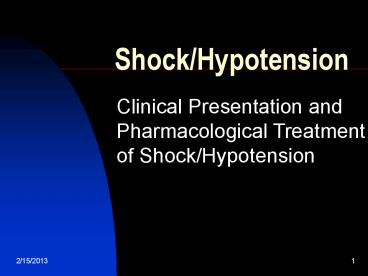Shock/Hypotension - PowerPoint PPT Presentation
1 / 31
Title:
Shock/Hypotension
Description:
Shock/Hypotension Clinical Presentation and Pharmacological Treatment of Shock/Hypotension Introduction Review the current view on clinical presentation and ... – PowerPoint PPT presentation
Number of Views:1470
Avg rating:3.0/5.0
Title: Shock/Hypotension
1
Shock/Hypotension
Clinical Presentation and Pharmacological
Treatment of Shock/Hypotension
2
Introduction
- Review the current view on clinical presentation
and management of shock with emphasis on
pharmacotherapy. - O. D. Polk, Jr., M.D. Assistant Professor of
Medicine Pulmonary Critical Care Medicine
3
Topics of Discussion
- Clinical Presentation
- Types of Circulatory Shock
- Management of Shock
- Inotropic Agents
- Vasodilators
4
Shock
- Term choc French for push or impact was
first published in 1743 by the physician LeDran - Belief symptoms arose from fear or some other
form of altered cerebral function - Crile in 1899 showed that replacement of blood
volume decreased mortality experimentally
5
SHOCK - DEFINITION
- A profound and widespread reduction in the
effective delivery of oxygen and other nutrients
to tissues leads first to reversible and then, if
prolonged, to irreversible cellular injury.
6
SHOCK-NEW CONCEPTS
- Shock is probably the most common and important
problem in critical care medicine. - Cardiogenic shock represents one of the most
important complications of IHD, the number one
cause of mortality in the US. - Hypovolemic and/or extracardiac obstructive shock
are major contributors to trauma-associated
morbidity and mortality. - Septic shock is the 13th most frequent cause of
death in the US. - Shock causes or contributes to multiple organ
dysfunction syndrome (MODS), organ failure, and
death.
Parillo JE 1999
7
MORTALITY FROM SHOCK
- Septic Shock
- 35 to 40 within one month
- Cardiogenic Shock
- 60 to 90
- Hypovolemic Shock
- Highly variable
8
STAGES OF SHOCK
- Preshock
- Shock
- 20 to 25 reduction of EBV
- Fall in CI to lt2.5
- Activation of mediators
- End-organ dysfunction
- Urine output decline
- Restlessness evolves into agitation, obtundation,
and coma - Acidosis further decreases CO and alters cellular
metabolic processes - Multiple organ system failure proceeds to cause
the demise of the patient
9
Determinants of Shock
- Inadequate tissue perfusion
- Sustained loss of effective circulatory blood
volume - Breakdown of cellular metabolism and
microcirculatory homeostasis - Hypoperfusion of peripheral tissue that leads to
a diminutive transcapillary exchange function - Disproportion between VO2 and DO2
10
Pathophysiology of Shock
- Shock develops with inadequate capillary
perfusion by decreased Cardiac Output following
heart attack (cardiogenic shock) or blood/volume
loss (hypovolemic shock)
11
Mediators of Shock
- Toxins
- Endotoxins
- Oligo- and polypeptides
- Complement Factors
- Opiods
- TNF, Interleukins
- Fatty Acid Derivatives
- Arachidonic acid metabolites
- Varia
- Calcium
12
Main Classes of Shock
- Hypovolemic Shock
- Distributive Shock
- Cardiogenic Shock
- Obstructive Shock
13
Hypovolemic Shock
- Hemorrhagic/Traumatic
- Dehydrative
- Burn
14
Distributive Shock
- Septic
- Anaphylactic/ Anaphylactoid
- Neurogenic
15
Cardiogenic Shock
- Myopathies
- Infarction involving gt40 of LV
- Dilated cardiomyopathies
- Myocardial depression of sepsis
- Arrhythmias
- Atrial fibrillation/flutter
- Ventricular fibrillation
- Bradyarrhythmias/Heart Block
- Mechanical abnormalities
- Valvular defects
- Ventricular aneurysm
16
Obstructive Shock
- Pulmonary Embolism
- Cardiac Tamponade
- Pneumothorax
17
Common Features of Shock
- Hypotension
- Systolic BP lt90 mmHg
- Drop systolic BP gt40 mmHg
- Cool, clammy skin
- Oliguria
- Objective measure of intravascular volume
depletion - Change in Mental Status
- Metabolic acidosis
18
Other Signs of Hypovolemia
- Tachycardia
- Orthostatic hypotension
- Poor skin turgor
- Absent axillary sweat
- Dry mucous membranes
19
Management of Shock
- Shock begins when DO2 (delivery of oxygen) to the
cells is inadequate to meet metabolic demand - The major therapeutic goals in shock therefore
are sufficient tissue perfusion and oxygenation - Early diagnosis remains a major problem
20
ShockInitial Diagnostic Steps
- History and Physical
- Laboratory
- CBC
- Coags
- ABGs
- Biochemical profile
- Lactate
- EKG
- Chest x-ray
21
ShockInitial Management
- Venous access
- Central venous catheter
- Arterial catheter
- EKG monitoring
- Pulse oximetry
- Hemodynamic support (MAPlt60 mmHg)
- Fluid Challenge
- Vasopressors for patients unresponsive to fluids
22
Complicated Shock
- Pulmonary Artery Catheterization done to measure
- Cardiac output
- Filling pressures
- Echocardiography done to look at
- Pericardial fluid
- Cardiac function (non-invasively)
- Valve or shunt abnormalities
23
(No Transcript)
24
Hemodynamic Characteristics in Different Types of
Shock
/
25
Inotropic Agents and Vasodilators
- Vasoactive drugs are an important pharmacologic
defense in the treatment of shock. - May be required to support BP in the early stages
of shock. - These agents may be needed to
- Enhance CO through the use of inotropic agents
- Increase SVR through the use of vasopressors
26
Effects of Inotropic Agents and Vasodilators
1
Drug Receptor CO SVR Dose Range
0
0 -
(mg/kg/min)
27
Effects of Inotropic Agents and Vasodilators
2
Drug CO SVR Dose Range
(mg/kg/min)
28
Dopamine An endogenous precursor of
norepinephrine withmultiple dose-related effects
- Low Dose (0.5 - 3 µg/kg/min)
- Predominantly dopaminergic (DR) effects
- Enhanced blood flow to renal and splanchnic beds
- Moderate Dose (5 -10 µg/kg/min)
- Positive inotropic effects (?1)
- High Dose (gt10 µg/kg/min)
- a-actions (vasoconstriction)
29
Indications for Selected Vasoactive Drugs
30
ComplicationsVasopressors and Inotropic Agents
- Hypoperfusion
- Dysrhythmias
- Myocardial ischemia
- Local effects
- Skin necrosis
- Hyperglycemia
- Unique drug interactions/contraindications
- Pheochromocytoma
- Avoid dobutamine in the setting of IHSS
- Patients receiving MAO Inhibitors
31
Reference
Pharmacotherapy of Shock. In The Pharmacologic
Approach to the Critically Ill Patient, 3rd ed.
Williams Wilkins,1994, pp 1104 1121.

